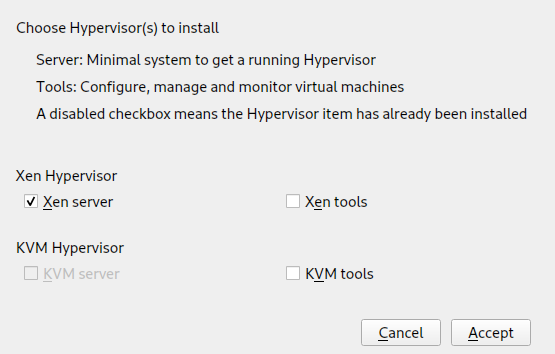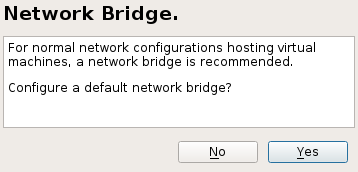33 Setting up a KVM VM Host Server #
This section documents how to set up and use SUSE Linux Enterprise Server 15 SP3 as a QEMU-KVM based virtual machine host.
In general, the virtual guest system needs the same hardware resources as if it were installed on a physical machine. The more guests you plan to run on the host system, the more hardware resources—CPU, disk, memory, and network—you need to add to the VM Host Server.
33.1 CPU support for virtualization #
To run KVM, your CPU must support virtualization, and virtualization needs
to be enabled in BIOS. The file /proc/cpuinfo includes
information about your CPU features.
To find out whether your system supports virtualization, see Section 7.1.1, “KVM hardware requirements”.
33.2 Required software #
The KVM host requires several packages to be installed. To install all necessary packages, do the following:
Verify that the yast2-vm package is installed. This package is YaST's configuration tool that simplifies the installation of virtualization hypervisors.
Run › › .
Figure 33.1: Installing the KVM hypervisor and tools #Select and preferably also , and confirm with .
During the installation process, you can optionally let YaST create a for you automatically. If you do not plan to dedicate an additional physical network card to your virtual guests, network bridge is a standard way to connect the guest machines to the network.
Figure 33.2: Network bridge #After all the required packages are installed (and new network setup activated), try to load the KVM kernel module relevant for your CPU type—
kvm-intelorkvm-amd:#modprobe kvm-intelCheck if the module is loaded into memory:
>lsmod | grep kvm kvm_intel 64835 6 kvm 411041 1 kvm_intelNow the KVM host is ready to serve KVM VM Guests. For more information, see Chapter 35, Running virtual machines with qemu-system-ARCH.
33.3 KVM host-specific features #
You can improve the performance of KVM-based VM Guests by letting them fully use specific features of the VM Host Server's hardware (paravirtualization). This section introduces techniques to make the guests access the physical host's hardware directly—without the emulation layer—to make the most use of it.
Examples included in this section assume basic knowledge of the
qemu-system-ARCH command line
options. For more information, see Chapter 35, Running virtual machines with qemu-system-ARCH.
33.3.1 Using the host storage with virtio-scsi #
virtio-scsi is an advanced storage stack for
KVM. It replaces the former virtio-blk stack for
SCSI devices pass-through. It has several advantages over
virtio-blk:
- Improved scalability
KVM guests have a limited number of PCI controllers, which results in a limited number of possibly attached devices.
virtio-scsisolves this limitation by grouping multiple storage devices on a single controller. Each device on avirtio-scsicontroller is represented as a logical unit, or LUN.- Standard command set
virtio-blkuses a small set of commands that need to be known to both thevirtio-blkdriver and the virtual machine monitor, and so introducing a new command requires updating both the driver and the monitor.By comparison,
virtio-scsidoes not define commands, but rather a transport protocol for these commands following the industry-standard SCSI specification. This approach is shared with other technologies, such as Fibre Channel, ATAPI, and USB devices.- Device naming
virtio-blkdevices are presented inside the guest as/dev/vdX, which is different from device names in physical systems and may cause migration problems.virtio-scsikeeps the device names identical to those on physical systems, making the virtual machines easily relocatable.- SCSI device pass-through
For virtual disks backed by a whole LUN on the host, it is preferable for the guest to send SCSI commands directly to the LUN (pass-through). This is limited in
virtio-blk, as guests need to use the virtio-blk protocol instead of SCSI command pass-through, and, moreover, it is not available for Windows guests.virtio-scsinatively removes these limitations.
33.3.1.1 virtio-scsi usage #
KVM supports the SCSI pass-through feature with the
virtio-scsi-pci device:
# qemu-system-x86_64 [...] \
-device virtio-scsi-pci,id=scsi33.3.2 Accelerated networking with vhost-net #
The vhost-net module is used to accelerate KVM's
paravirtualized network drivers. It provides better latency and greater
network throughput. Use the vhost-net driver by starting
the guest with the following example command line:
# qemu-system-x86_64 [...] \
-netdev tap,id=guest0,vhost=on,script=no \
-net nic,model=virtio,netdev=guest0,macaddr=00:16:35:AF:94:4B
Note that guest0 is an identification string of the
vhost-driven device.
33.3.3 Scaling network performance with multiqueue virtio-net #
As the number of virtual CPUs increases in VM Guests, QEMU offers a way of improving the network performance using multiqueue. Multiqueue virtio-net scales the network performance by allowing VM Guest virtual CPUs to transfer packets in parallel. Multiqueue support is required on both the VM Host Server and VM Guest sides.
The multiqueue virtio-net solution is most beneficial in the following cases:
Network traffic packets are large.
VM Guest has many connections active at the same time, mainly between the guest systems, or between the guest and the host, or between the guest and an external system.
The number of active queues is equal to the number of virtual CPUs in the VM Guest.
While multiqueue virtio-net increases the total network throughput, it increases CPU consumption as it uses of the virtual CPU's power.
The following procedure lists important steps to enable the multiqueue
feature with qemu-system-ARCH. It assumes that a tap
network device with multiqueue capability (supported since kernel version
3.8) is set up on the VM Host Server.
In
qemu-system-ARCH, enable multiqueue for the tap device:-netdev tap,vhost=on,queues=2*N
where
Nstands for the number of queue pairs.In
qemu-system-ARCH, enable multiqueue and specify MSI-X (Message Signaled Interrupt) vectors for the virtio-net-pci device:-device virtio-net-pci,mq=on,vectors=2*N+2
where the formula for the number of MSI-X vectors results from: N vectors for TX (transmit) queues, N for RX (receive) queues, one for configuration purposes, and one for possible VQ (vector quantization) control.
In VM Guest, enable multiqueue on the relevant network interface (
eth0in this example):>sudoethtool -L eth0 combined 2*N
The resulting qemu-system-ARCH command line will look
similar to the following example:
qemu-system-x86_64 [...] -netdev tap,id=guest0,queues=8,vhost=on \ -device virtio-net-pci,netdev=guest0,mq=on,vectors=10
Note that the id of the network device
(guest0 ) needs to be identical for both options.
Inside the running VM Guest, specify the following command with root
privileges:
>sudoethtool -L eth0 combined 8
Now the guest system networking uses the multiqueue support from the
qemu-system-ARCH hypervisor.
33.3.4 VFIO: secure direct access to devices #
Directly assigning a PCI device to a VM Guest (PCI pass-through) avoids performance issues caused by avoiding any emulation in performance-critical paths. VFIO replaces the traditional KVM PCI Pass-Through device assignment. A prerequisite for this feature is a VM Host Server configuration as described in Important: Requirements for VFIO and SR-IOV.
To be able to assign a PCI device via VFIO to a VM Guest, you need to find out which IOMMU Group it belongs to. The IOMMU (input/output memory management unit that connects a direct memory access-capable I/O bus to the main memory) API supports the notion of groups. A group is a set of devices that can be isolated from all other devices in the system. Groups are therefore the unit of ownership used by VFIO.
Identify the host PCI device to assign to the guest.
>sudolspci -nn [...] 00:10.0 Ethernet controller [0200]: Intel Corporation 82576 \ Virtual Function [8086:10ca] (rev 01) [...]Note down the device ID (
00:10.0in this case) and the vendor ID (8086:10ca).Find the IOMMU group of this device:
>sudoreadlink /sys/bus/pci/devices/0000\:00\:10.0/iommu_group ../../../kernel/iommu_groups/20The IOMMU group for this device is
20. Now you can check the devices belonging to the same IOMMU group:>sudols -l /sys/bus/pci/devices/0000\:01\:10.0/iommu_group/devices/ [...] 0000:00:1e.0 -> ../../../../devices/pci0000:00/0000:00:1e.0 [...] 0000:01:10.0 -> ../../../../devices/pci0000:00/0000:00:1e.0/0000:01:10.0 [...] 0000:01:10.1 -> ../../../../devices/pci0000:00/0000:00:1e.0/0000:01:10.1Unbind the device from the device driver:
>sudoecho "0000:01:10.0" > /sys/bus/pci/devices/0000\:01\:10.0/driver/unbindBind the device to the vfio-pci driver using the vendor ID from step 1:
>sudoecho "8086 153a" > /sys/bus/pci/drivers/vfio-pci/new_idA new device
/dev/vfio/IOMMU_GROUPwill be created as a result,/dev/vfio/20in this case.Change the ownership of the newly created device:
>sudochown qemu.qemu /dev/vfio/DEVICENow run the VM Guest with the PCI device assigned.
>sudoqemu-system-ARCH [...] -device vfio-pci,host=00:10.0,id=ID
As of SUSE Linux Enterprise Server 15 SP3, hotplugging of PCI devices passed to a VM Guest via VFIO is not supported.
You can find more detailed information on the VFIO
driver in the /usr/src/linux/Documentation/vfio.txt
file (package kernel-source needs to be
installed).
33.3.5 VirtFS: sharing directories between host and guests #
VM Guests usually run in a separate computing space—they are provided their own memory range, dedicated CPUs, and file system space. The ability to share parts of the VM Host Server's file system makes the virtualization environment more flexible by simplifying mutual data exchange. Network file systems, such as CIFS and NFS, have been the traditional way of sharing directories. But as they are not specifically designed for virtualization purposes, they suffer from major performance and feature issues.
KVM introduces a new optimized method called VirtFS (sometimes called “file system pass-through”). VirtFS uses a paravirtual file system driver, which avoids converting the guest application file system operations into block device operations, and then again into host file system operations.
You typically use VirtFS for the following situations:
To access a shared directory from several guests, or to provide guest-to-guest file system access.
To replace the virtual disk as the root file system to which the guest's RAM disk connects during the guest boot process.
To provide storage services to different customers from a single host file system in a cloud environment.
33.3.5.1 Implementation #
In QEMU, the implementation of VirtFS is simplified by defining two types of devices:
virtio-9p-pcidevice which transports protocol messages and data between the host and the guest.fsdevdevice which defines the export file system properties, such as file system type and security model.
>sudoqemu-system-x86_64 [...] \ -fsdev local,id=exp11,path=/tmp/2,security_model=mapped3 \ -device virtio-9p-pci,fsdev=exp14,mount_tag=v_tmp5
Identification of the file system to be exported. | |
File system path on the host to be exported. | |
Security model to be used— | |
The exported file system ID defined before with | |
Mount tag used later on the guest to mount the exported file system. |
Such an exported file system can be mounted on the guest as follows:
>sudomount -t 9p -o trans=virtio v_tmp /mnt
where v_tmp is the mount tag defined earlier with
-device mount_tag= and /mnt is the
mount point where you want to mount the exported file system.
33.3.6 KSM: sharing memory pages between guests #
Kernel Same Page Merging (KSM) is a Linux kernel feature that merges identical memory pages from multiple running processes into one memory region. Because KVM guests run as processes under Linux, KSM provides the memory overcommit feature to hypervisors for more efficient use of memory. Therefore, if you need to run multiple virtual machines on a host with limited memory, KSM may be helpful to you.
KSM stores its status information in the
files under the /sys/kernel/mm/ksm directory:
> ls -1 /sys/kernel/mm/ksm
full_scans
merge_across_nodes
pages_shared
pages_sharing
pages_to_scan
pages_unshared
pages_volatile
run
sleep_millisecs
For more information on the meaning of the
/sys/kernel/mm/ksm/* files, see
/usr/src/linux/Documentation/vm/ksm.txt (package
kernel-source).
To use KSM, do the following.
Although SLES includes KSM support in the kernel, it is disabled by default. To enable it, run the following command:
#echo 1 > /sys/kernel/mm/ksm/runNow run several VM Guests under KVM and inspect the content of files
pages_sharingandpages_shared, for example:>while [ 1 ]; do cat /sys/kernel/mm/ksm/pages_shared; sleep 1; done 13522 13523 13519 13518 13520 13520 13528

